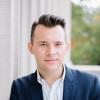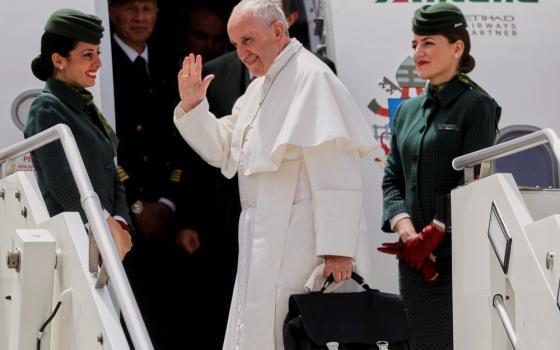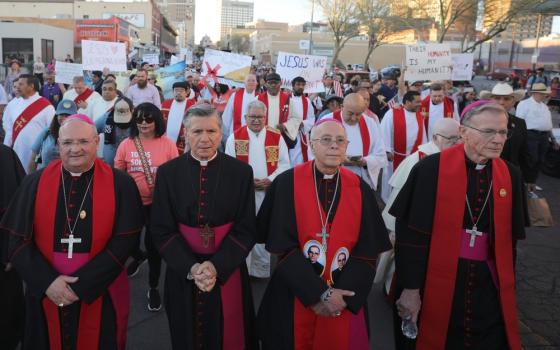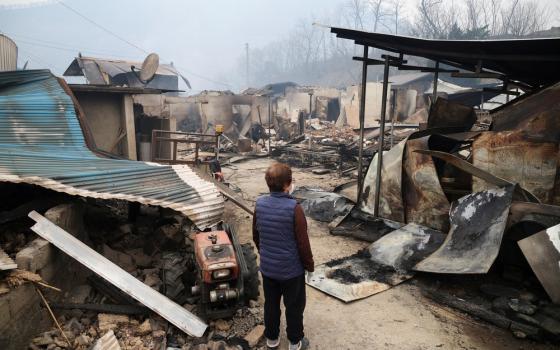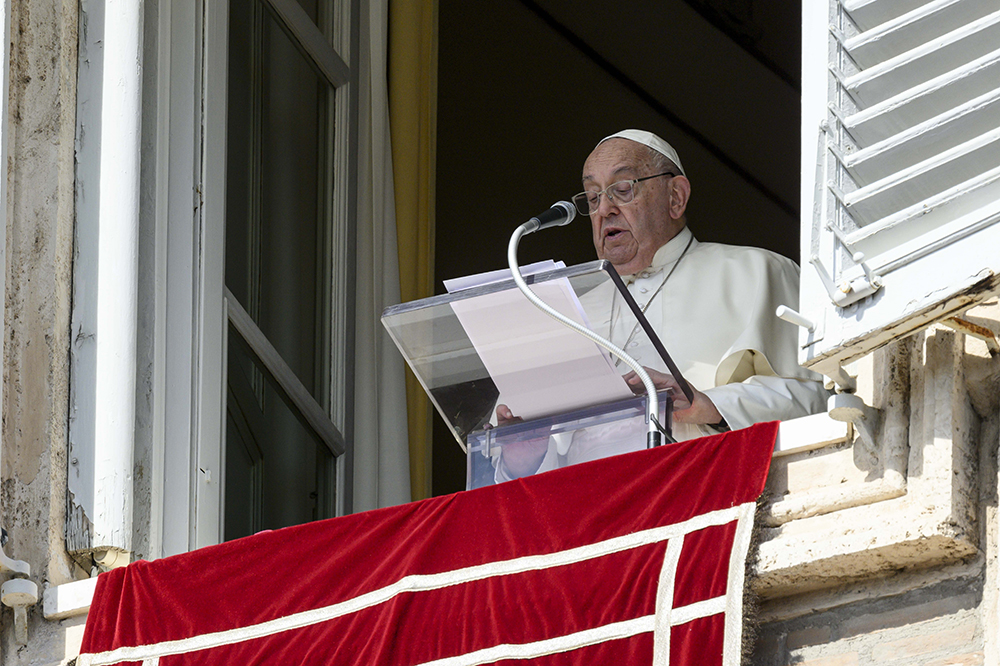
Pope Francis leads the recitation of the Angelus prayer with visitors gathered in St. Peter's Square at the Vatican Oct. 6, 2024. At the end of the Angelus, the pope announced he would create 21 new cardinals Dec. 8. (CNS/Vatican Media)
Among the newly named 21 cardinals announced by Pope Francis on Oct. 6, the youngest is 44 years old and the oldest is 99.
The surprise consistory, which will be held on Dec. 8, will, in many respects, be similar to the previous nine consistories during Francis' nearly 12 year papacy with the new red hats being bestowed to those from the peripheries, rather than major world capitals.
Yet with the ceremony taking place just nine days before his 88th birthday, Francis' latest power play ensures that the College of Cardinals — whose main job is to elect the next pope — is now overwhelmingly made of clergy of his own choosing.
But who are all the pope's new men and what will this mean for the next pope?
Advertisement
Unexpected names, overlooked places and people
Of the 21 new cardinals, 20 are under the age of 80 and thus eligible to vote in a papal conclave.
Archbishop Angelo Acerbi, 99, has served in the Vatican's diplomatic corps for over 50 years. Over the course of his international career, he was held hostage by guerrillas in Colombia, helped to negotiate church-state relations in Spain and helped to rebuild Hungary's Catholic hierarchy after the fall of communism. He won't be able to vote in a future conclave — or perhaps even be alive to witness it — but this is Francis' symbolic chapeau for a storied career of service.
On the other end of the spectrum is Redemptorist Bishop Mykola Bychok, the 44-year-old Ukrainian Greek Catholic prelate who leads the Eparchy of Sts. Peter and Paul in Melbourne, Australia.
By naming Bychok a cardinal, Francis now bestows his first red hat to a Ukrainian Greek Catholic, opting to overlook its primate, Major-Archbishop Sviatoslav Shevchuk of Kyiv–Galicia, who has previously been critical of some of the pope's remarks on the ongoing war in Ukraine.
Bychok's elevation will also give Australia its first cardinal following the death of Cardinal George Pell in January 2023. In typical Francis fashion, the move bypasses the major sees of Sydney and Melbourne, though the current leaders of those two dioceses who are more associated with the late Pell, who regularly quarreled with Francis, were never expected to receive the honor. More surprising is the decision to bypass Salesian Archbishop Timothy Costelloe, current president of the Australian Catholic Bishops' Conference, who has been deeply involved in the pope's ongoing synod on synodality.
While the traditional sees of Los Angeles, Milan and Paris remain without cardinals, Francis' newest members in the Catholic Church's most elite club will now also include Serbian Archbishop Ladislav Nemet (who is the current vice president of the Council of the Bishops' Conferences of Europe); Archbishop Roberto Repole, the 57-year old Italian theologian and Archbishop of Turin; and the pope's own travel agent, Msgr. George Jacob Koovakad, who is responsible for planning Francis' international trips.
Koovakad has served in the Vatican's diplomatic service since 2006 and it would be highly unusual for him to remain in his current post upon being elevated as a cardinal. The 51-year-old native of Kerala, India, has been rumored as a potential successor to Bombay Cardinal Oswald Gracias, a longtime close adviser to Francis who will turn 80 in December, and, according to church law, loses his right to participate in a conclave.
Record-setting religious order picks
While history's first Jesuit pope has always enjoyed elevating men from religious orders to the College of Cardinals, he will set a new record with this consistory class of 11 religious order clergy getting the red hat.
Of the 21 new names, 11 of the new bishops and priests being made cardinal hail from religious orders.
There will be three Franciscans (Archbishop Luis Gerardo Cabrera Herrera of Guayaquil, Ecuador; Archbishop Jaime Spengler of Porto Alegre, Brazil; and Bishop Paskalis Bruno Syukur of Bogor, Indonesia); and one Conventual Fransiscan — Belgian-born Archbishop Dominique Joseph Mathieu, whose current posting in the Iranian capital and previous work in Lebanon also sends a clear political signal from the pope amid the threat of all-out regional war.
Two Divine Word Missionaries who will be created cardinal are Archbishop Tarcisio Isao Kikuchi of Tokyo, Japan, (who is also the current president of Caritas Internationalis, the Catholic Church's global charity network) and Nemet of Serbia.

Chicago-born Cardinal Robert Prevost's red biretta and scroll, are seen next to his chair as he greets well-wishers in the Apostolic Palace at the Vatican after a consistory where Pope Francis made him and 20 other prelates cardinals Sept. 30, 2023. (CNS/Lola Gomez)
Scalabrian Fr. Fabio Baggio, who heads the migrants and refugees division of the Vatican's Dicastery for Integral Human Development, will also receive the red hat. In many ways, Baggio's elevation mirrors that of his boss, Jesuit Cardinal Michael Czerny, who previously held Baggio's current position. In 2019, the pope unexpectedly made the then-Jesuit priest a cardinal, and then, in 2023, tapped him to lead the entire dicastery. In Rome, there is already speculation that Baggio could follow a similar path and replace the 78-year-old Czerny when he reaches the mandatory retirement age of 80 in two years.
Rounding out the list of religious order soon-to-be cardinals is the Ukrainian Redemptorist Bychok, Vincentian Vicente Bokalic Iglic of Santiago del Estero, Argentina, and two Dominicans — Archbishop Jean-Paul Vesco of Algiers, Algeria, and Fr. Timothy Radcliffe.
Radcliffe's selection is a clear signal that one can have many lives in the Catholic Church. The Oxford trained theologian was former Master of the Dominican Order and was previously blocked from several top jobs in the Catholic Church under both Popes John Paul II and Benedict XVI. Francis, however, has entrusted Radcliffe to serve as spiritual master of his legacy project, the synod on synodality.
At 79, Radcliffe has less than a year before he loses his right to participate in a future papal conclave. Even so, he would still be able to take part in the General Congregations — the meetings of all the cardinals about the state of the church that take place before the election of the next pope — and by giving the white-habited Dominican a red hat, Francis clearly wants Radcliffe in the room when those conversations about the future of the Catholic Church are taking place.
New men, new math
As of the Dec. 8 consistory, Francis will have named 80% of the men who will elect his successor, marking an increase of 7% from his last consistory in 2023. Of the eligible cardinal-electors at that time, 112 will have been named by Francis, 23 by Benedict XVI and 5 by Pope John Paul II.
Clocking in at 140 electors, that number exceeds the limit of 120 set by Pope Paul VI in 1975 and will not drop below that number again until after July 2026. Both Popes John Paul II and Benedict XVI also surpassed that number at various points during their papacies, with John Paul II going as high as 135 in 2001.
According to an analysis from the Pew Research Center, since Francis' election in 2013, the percentage of European cardinals has continuously dropped, while there has been a steady rise in African, Asia Pacific and Latin American representation — a trend that will continue with this new crop.
When the new men gather in St. Peter's Basilica on Dec. 8 for the pope to bestow their new hats and rings, they will hear from 99-year-old Acerbi, whose name the pope announced first and, according to tradition, will speak on behalf of the new cohort.
And in choosing Acerbi, perhaps the 87-year-old pope was also sending yet another message: one's age does not limit one's influence.
